By Oleg Lomakov, Lead Game Designer, AppQuantum
Frozen City is a mobile tycoon game inspired by the PC and console hit Frostpunk, which also recently came to the mobile platform.
As of March 16, 2023, Frozen City had earned $11.3 million on in-apps and had been downloaded 10.8 million times. The RPD of the iOS and Android versions is around $1.05. The game has achieved all this since December 2022.
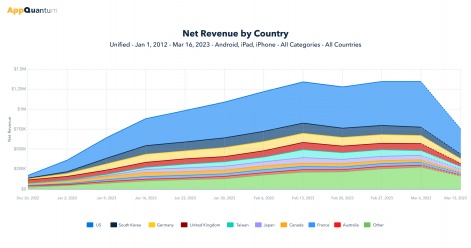
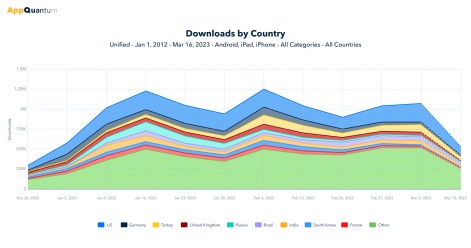
So, what is the secret of Frozen City's success? In this article, Oleg Lomakov, lead game designer at AppQuantum explains its gameplay, monetization, and other game components.
Let’s talk a little about the "muse"
Frostpunk is a harsh strategy game about survival in an endless winter. The player will have to build a new city around a large coal furnace and lead the fight for a comfortable life in warmth.
This game is not about joy and colourful adventures. Frostpunk presents situations in which players must make serious decisions and sacrifices for the new society to function. Are wards freezing cold outside? Build tents! Yeah, then there won't be enough resources for improvements to get more food. Do you need resources before everyone starves to death? Sign an ordinance for extended work shifts or start using child labour. By the way, a quarter of the residents are already sick in the cold and can't work, and one worker will have to have his leg amputated. I forgot to tell you! The forecast is extremely cold today. And now, you're about to be hoisted on pitchforks for child labour and lack of tents! Live with that! Oh, wait, not the pitchforks.
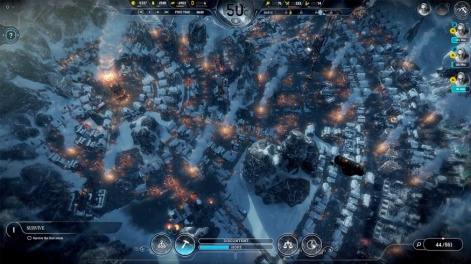
In the case of Frozen City, you have no reason to worry because the mobile world of casual games is much kinder. Or is it?
Frozen City gameplay features
The first session may seem like a classic, casual tycoon game. It takes about half an hour to complete the starting map without rushing, and the tasks are pretty standard: build and improve structures. There are a couple of optional (and already familiar) genre complications. Working time mode and distribution of human resources on jobs. An apocalypse is an apocalypse, but you must respect the work-life balance.
At the first level, the player gets enough managers to play without any problems. They multiply the production of resources in factories and open access to additional jobs. There is plenty of evolve currency to upgrade them at this stage too.
There are two types of evolve currency. One for levelling up the character and another for raising the upgrading limit. Unusually, there is no soft currency. It is replaced by resources, among which there is no most valuable, and the gradation of their necessity varies from map to map. Some require other resources to produce them, which builds up a production chain. When the player learns how to handle all kinds of currencies and find a balance, the game will give them a new, more serious challenge.
The usual thing for other tycoon games is to pump up the factories to a comfortable level and watch everything work, sipping your hot cup of coffee. But in this game, snowstorms hit the camp occasionally, noticeably lowering the environment's temperature. The more play time passes, the harsher the storms get. What we understand quickly about Frozen City is that it is quite realistic to go into the negative, and there's no way to relax.
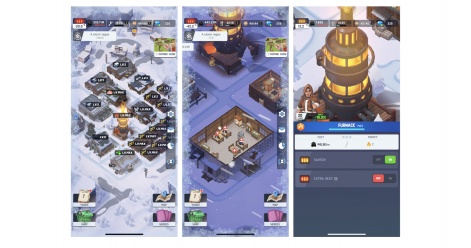
Some problems of people management in Frozen City
- If you exhaust the workers with long night shifts (which is possible) or do not create comfortable conditions to let them rest in the houses, they will run away from the camp.
- If they don’t have enough food (it still needs to be cooked!), they will starve to death
- If you don't worry about upgrading the furnace or don't accumulate enough fuel to keep it warm, they'll get sick and stay in the infirmary.
- If there are no places in the infirmary and, as a consequence, no treatment, they will also die.
- If public dissatisfaction accumulates, the workers will go on strike.
We already know how to solve the currency crisis in games like this. Quit the game, wait until there is enough income offline, pick it up, and upgrade the building for better production. But in Frozen City, the player pays for everything with resources, not gold or other familiar currency. Moreover, as the building is levelling up, the required resource for upgrading may suddenly change to absolutely another one.
As an experience for the casual player, it is harsh but rewarding. As a product that monetizes through "bottlenecks,” it is fantastic.
We should pay tribute to the developers because when designing a level, they immediately plan which resource will be in short supply. At the same time, the right factory will need an "elite" manager, which is very difficult to get from the usual chests. A level ends when the player completes all the quests on the current map. The player also receives an "elite" chest with the appropriate manager and sets of evolve currencies as a reward.
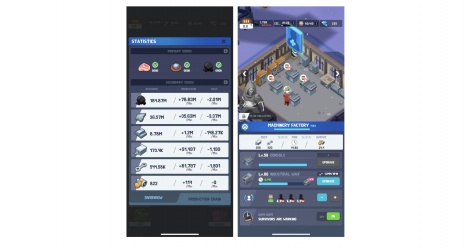
Meta
As for the meta, Frozen City combines elements from gacha, battler, and adventure mechanics.
- Managers. Finding a mobile tycoon game without this mechanic is hard. However, Frozen City can be passed only with managers you like, not using all of them at once. Spoiler, it won’t be easy because managers help in production and participate in battles (about that a little later). Each of them has their own role in factories and combat, so sending a medic somewhere other than the infirmary won't work. Also, the manager's level determines the factory's efficiency and the available workstations.
- Battler was a logical continuation of the gacha system. You will need characters from accumulated cards with their own level, role, and faction for battle. By collecting four characters of one faction in a squad, the player gets a bonus in the form of a lot of minion-helpers. Why fight at all? Each completed battle increases the passive evolve currency income.
- Adventure. Not a battle, of course, but you have to fight! An adventure consists of a long-distance raid where your squad encounters enemies. For winning, you can get resources and add a new ally to the team. Each such adventure has 20 stages, for which you receive a prize. After completing 50 stages from different raids, the player can open a chest with any character card. However, you can only participate in an adventure once per day.
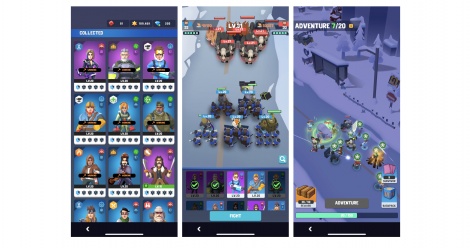
Impact of meta-activity on the game and users
- First, the player has something to occupy themself with while waiting.
- The player becomes more familiar with the stats of the characters and their advantages, learning more about their value.
- In addition to creating bottle-necks for monetization, gacha cards allow the developer to add variation to levels and control the increase in difficulty.
LTE
Frozen City has different time events. Why are they needed here and how do they affect the players? First, let's look at some LTEs and their features.
For the Grampa's Farm event, the developers didn't just do a reskin, they reassembled the game flow. This way, the game became more similar to the familiar tycoons. One universal soft currency (money), and the process is built around multiplying earnings, with food always in abundance and you have no chance of freezing.
For completing quests, the player receives special tokens for the slot machine, where you can win various bonuses, including skill points. These points are spent to increase the cost of selling goods, the volume of truck shipments, cheaper building upgrades, etc. LTE has rewards for passing the money milestones and a leaderboard with additional rewards for high rankings. The rivalry here is no small thing.
For another LTE, Fish Farming, the developers chose a flow similar to Grampa's Farm, but here the skill points are replaced by cards obtained from chests (like with the managers' mechanics).
The Last Autumn event’s core has the least difference in visuals and gameplay from the base event: resources instead of currencies, a furnace, and a cold environment. The focus is primarily on people management: only 16 workers can be on the map, with the help of which you need to build a multi-threaded production in 3 days. Rewards for passing milestones are not focused on chests and cards but on currency to increase the maximum level of the characters.
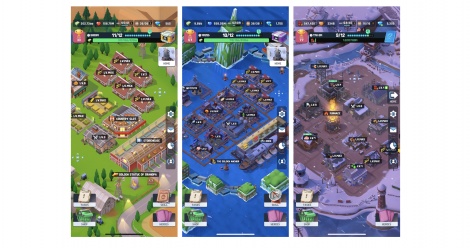
How do these LTEs affect the game and the player?
- The player gets a legal opportunity to pick up many rewards for free that would have to have been paid for in the store.
- The player challenges himself. Can he be successful with familiar entities but in different circumstances?
- The developer gets an audience that is more likely to play the game during the LTE emergence period (by the way, they have a minimum break). The leaderboard offers additional rewards and fuels competitive excitement. Even if the player wasn't planning on buying any extra bonuses from the LTE store, the feeling of "I was good, but not enough. Others were better" is conducive to converting to a paying player.
Visual / UI
The game's visuals deserve individual attention. The game is gratifying visually, as the developers spared no effort on its assets. It's easier for the player to feel their progress when it's visible. Frozen City has implemented this approach in two ways.
- Improving the visuals of buildings after upgrading. Each new level of construction is a different model that looks "richer" and "more solid" than the previous ones. Even individual elements can change their appearance after minor improvements to building parameters.
- Interface. All sections are terse, with no button clutter and no screaming suggestions. The player won't get confused or uncomfortable because of the visual noise.
The visual rewards have a pleasant effect on the feeling of the game. At the end of each level, the player sees statistics with his achievements and a small clip showing which way of development the city has overcome.
Monetization
Frozen City's monetization includes in-app, hard currency, and Rewarded Video (RV). In general, everything is standard. But, as we said at the beginning, the game earned $11.3 million on in-apps alone. What in-apps of this project are included?
- Packs. for beginners, seasonal and a few with manager cards for each level to get rare managers. At higher levels, special sets contain chests instead of specific cards.
- Hard currency. Standard hard currency bundles show the additional profit from their purchase.
- Subscriptions with three sets of benefits: Gems+ (a fixed amount of hard currency), Ads+ (standard NoAds), and Main City+ (ubiquitous improvements).
- LTE-VIP. It is a one-time purchase that doubles your income and offline time earnings in LTEs. Purchased separately for each event.
The player also has four spots of use for hard currency: chests, extra cards and evolve currency, constructing acceleration, and time skip. Despite the well-balanced gameplay, sooner or later, you will want to improve your conditions, for which the developers are well-prepared.
For example, you can get a chest with a guaranteed manager card once every 8 hours, but the chance of getting a rare card is tiny. However, you can buy better crates and increase the chance accordingly. If the player doesn’t have enough cards or currency to raise the level limit, they can buy the missing items with diamonds. The long construction period of buildings is also decreased through the purchase of instant completion. Do you need resources but don’t want to wait too long? Purchasing a time skip will solve the problem!
What about the RV? The player can get a random resource and an extra chest using them. In the first case, a small placement appears, allowing you to pick up a lot of resources for building improvements (which is very useful!) after watching an ad. As we said before, you can get a free chest once every 8 hours, but it's also possible to get an extra one by watching a commercial once every 8 hours.
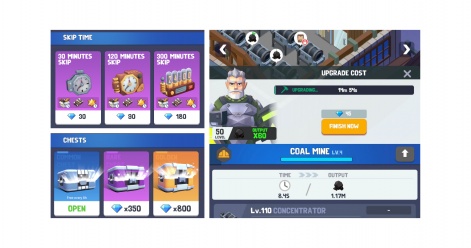
We have analysed the gameplay and monetization of the game in detail. Now it's time to answer the main question.
What are the player’s motivations and the reasons for the success of Frozen City?
Increased empathic attachment of the player to the world. They care not only about the comfort of their wards but also about their survival. Of course, the game is casual and does not punish the player much for miscalculations, but it seems like a challenge for this kind of project.
A familiar theme. The game will surely interest Frostpunk fans and survivalist enthusiasts unfamiliar with this title. Besides, a freezing post-apocalypse is still a fresh kind of post-apocalypse. There's a reason why we think that the snowy apocalypse setting played a significant role in the project's success. The publisher of Frozen City has another project with which it is usually compared, White Out Survival. According to our information, this project was initially tested on the market in different settings, such as "survival in the desert," "sea world," and "development of civilizations," but the best performance was shown by, obviously, the same frozen world.
Simplified logistics. The developers found a balance between traditional casual tycoons and simulators with complex economic chains. Potentially, it is possible to reach the audience of both genres.
Different levels are different introductions. Each level is not "prestige" in the classical sense, nor is it a repetition of previously seen, but other challenges within the same theme. What kind of production will appear at that level? This is how interest is maintained.
There is always something to do in the game. LTE and mini-games complement the core gameplay.
AppQuantum intends to continue to share details on the most interesting projects out on the mobile market and analyse the reasons behind their success.
Edited by Paige Cook



















